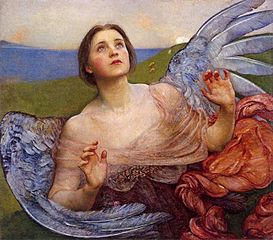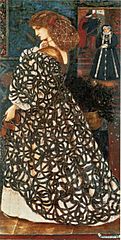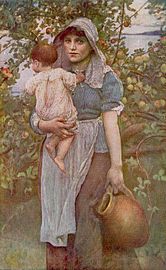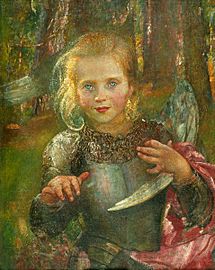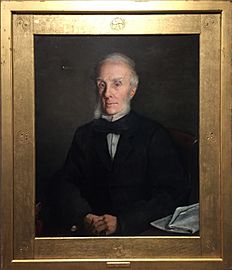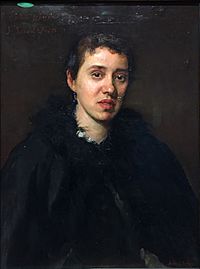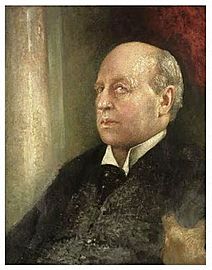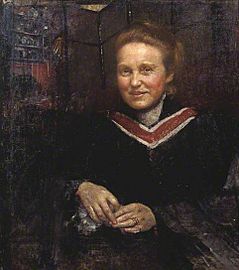Annie Swynnerton facts for kids
Quick facts for kids
Annie Louisa Robinson Swynnerton
|
|
|---|---|
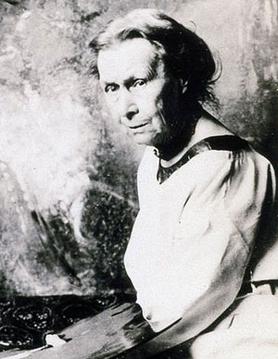
Annie Swynnerton in 1931
|
|
| Born |
Annie Louisa Robinson
26 February 1844 Hulme, Manchester, England
|
| Died | 24 October 1933 (aged 89) Hayling Island, England
|
| Nationality | English |
| Education | Manchester School of Art, Académie Julian |
| Spouse(s) | Joseph Swynnerton |
Annie Louisa Swynnerton (born Robinson; 26 February 1844 – 24 October 1933) was an important British painter. She was known for her beautiful portraits and symbolic artworks.
Annie studied art at the Manchester School of Art and later at the Académie Julian in Paris. She then moved to Rome, Italy, with her husband, Joseph Swynnerton, who was a sculptor.
Famous artists like George Frederic Watts and Sir Edward Burne-Jones influenced Annie's work. Another well-known painter, John Singer Sargent, admired her art. He helped her become the first woman ever elected as an associate member of the Royal Academy of Arts in 1922.
Annie painted portraits of famous people, including writer Henry James and women's rights leader Millicent Fawcett. Many of her paintings are kept at the Manchester Art Gallery. You can also find her art in other cities like Glasgow, Dublin, Paris, and Melbourne, Australia. Annie was also a close friend of important women's rights activists, like the Pankhurst family.
Contents
Early Life
Annie Louisa Robinson was born in Hulme, Manchester, England, in 1844. Her father, Francis Robinson, was a lawyer. Annie had six sisters.
During a difficult time for her family, Annie helped by making and selling watercolours. Her sisters, Julia and Emily, also studied art at the Manchester School of Art. They were even mentioned as prize-winning students in a newspaper in 1873.
Art Education
Annie began her art training at the Manchester School of Art in 1871. She won a gold prize and a scholarship for her oil and watercolour paintings.
From 1874 to 1876, she studied art in Rome with her friend, artist Susan Isabel Dacre. After that, both women studied at the Académie Julian in Paris from 1877 to 1880. Annie was inspired by the works of a French painter named Jules Bastien-Lepage. She lived in Manchester in 1880 and later moved to London by 1882.
Her Art Style
Annie Swynnerton painted many different types of art, including portraits, figures, symbolic scenes, and landscapes. Artists like George Frederic Watts and Sir Edward Burne-Jones supported her career.
Her art style mixed ideas from different art movements. These included Neoclassicism (which looked back to ancient Greek and Roman art), Pre-Raphaelitism (which focused on detailed, colorful art), and Impressionism (which used visible brushstrokes to capture light and movement).
- George Frederic Watts, Edward Burne-Jones, and Annie Louisa Swynnerton's works
-
Annie Louisa Swynnerton, The Sense of Sight, oil on canvas, 1895, National Museums Liverpool
Annie was also very good at painting children. Her works often showed strong drawing skills and a sense of depth, almost like sculptures. She also used fresh, broken colours, similar to Impressionist painters.
-
Illusions, oil on canvas, 1900, Manchester Art Gallery
Her Career as an Artist
Annie Swynnerton shared an art studio with her friend Susan Isabel Dacre. In 1879, they both started the Manchester Society of Women Painters. This group helped women artists by offering art classes and showing their work in exhibitions. Annie's sister, Emily Robinson, was also a member.
Annie painted a portrait of Susan Isabel Dacre, which was shown at the Royal Academy of Arts in 1880. Susan Dacre later gave this painting to the Manchester Art Gallery in 1932. In 1895, Annie became the second woman to help choose which artworks would be shown at the Liverpool Autumn Exhibition.
She painted portraits of several important people, including members of the Garrett family. These included Agnes Garrett and Dame Millicent Garrett Fawcett, whose portrait is now at the Tate Gallery. She also painted Louisa Garrett Anderson.
Annie also painted people connected to the Garrett family, such as writer Henry James and Rev. William Gaskell, whose wife was the famous novelist Elizabeth Gaskell. The composer Ethel Smyth also supported Annie's art.
-
Henry James, by 1922
Annie Swynnerton showed her paintings at the Royal Academy of Arts for many years, from 1879 to 1886, and then from 1902 to 1934. The famous artist John Singer Sargent admired her work so much that he bought some of her paintings. He even gave her painting The Oreads to the nation.
Sargent played a big part in Annie's election in 1922. She became the first woman to be elected as an associate member of the Royal Academy since the 1700s. This was a huge achievement for women artists.
Annie's art was also shown in exhibitions in other cities, including Aberdeen, Doncaster, Huddersfield, Manchester, and even in Chicago and Pittsburgh in the United States. In 1893, her painting Florence Nightingale at Scutari was displayed at the Women's Exhibition during the Chicago World's Exposition. This painting showed how women artists could express deep feelings with strong artistic skill and colour.
Supporting Women's Rights
Annie Swynnerton was a strong supporter of the women's suffrage movement. This movement worked to get women the right to vote. In 1889, she signed a special document called the National Union of Women's Suffrage Societies' Declaration, which supported women's right to vote.
Personal Life
Annie met sculptor Joseph William Swynnerton, who was from the Isle of Man. They might have met when they were both living in Rome. They got married in 1883 and mostly lived in Rome, but they also had an art studio in London. They were married until Joseph died in 1910.
In her later years, Annie's eyesight became weaker. After her husband passed away, she lived in Chelsea, London, and Rome. She eventually settled on Hayling Island, England, where she died in 1933.
Collections
Annie Swynnerton's artworks are held in many important art collections around the world. Here are some of the places where you can see her paintings:
| Collection | Location | Works |
|---|---|---|
| Aberdeen Art Gallery & Museums | Aberdeen, Scotland |
|
| Ashmolean Museum of Art and Archaeology | Oxford, England |
|
| Birmingham Museums Trust | Birmingham, England |
|
| Bradford Museums and Galleries | Bradford, England |
|
| Brighton and Hove Museums and Art Galleries | Brighton, England |
|
| Cheltenham Art Gallery & Museum | Cheltenham, England |
|
| Gallery Oldham | Oldham, England |
|
| Glasgow Museums | Glasgow, Scotland |
|
| Manchester Art Gallery | Manchester, England |
|
| Metropolitan Museum of Art | New York City |
|
| Musée d'Orsay | Paris, France |
|
| National Gallery of Victoria | Melbourne, Australia |
|
| National Museums Liverpool | Liverpool, England |
|
| Nottingham City Museums and Galleries | Nottingham, England |
|
| Royal Academy of Arts | London, England |
|
| Royal Holloway, University of London | London, England |
|
| Salford Museum & Art Gallery | Salford, England |
|
| Tate Gallery | London, England |
|
See Also
 In Spanish: Annie Swynnerton para niños
In Spanish: Annie Swynnerton para niños
- List of English women artists
- Women Painters of the World, published 1905


